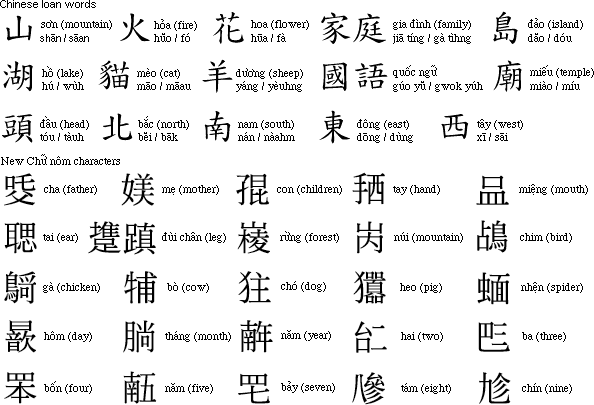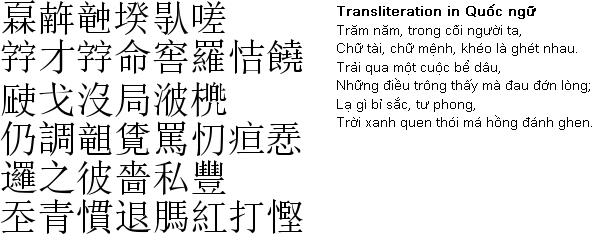 Chữ-nôm script
Chữ-nôm scriptVietnam was ruled by the Chinese for over a thousand years from 111 BC - 938 AD. As a result, the official written language was Classical Chinese, known as Chữ-nho (𡨸儒) in Vietnamese, which continued to be used in Vietnam, in parallel with Chữ-nôm (𡨸喃) and Quốc Ngữ, until about 1918.
Sometime during the 10th century the Vietnamese adapted the Chinese script to write their own language and called their script 'Chữ-nôm' (southern script). The earliest known example of writing in the Chữ-nôm script, an inscription on a stele at the Bảo Ân temple in Yên Lãng, Vĩnh Phúc province, dates from 1209 AD (Lý dynasty). It was during the Trần dynasty (家陳) in the 13th-14th centuries that the script was systematized and started to be used in literature.
Famous Vietnamese writers who wrote in the Chữ-nôm script include Emperor Trần Nhân Tông (1258-1308); the poets Nguyễn Thuyên and Nguyễn Sĩ Cố (1230-1312) and Nguyễn Trãi (1380-1442); and Hồ Quý Ly (1336-1407) who translated Chinese textbooks into Vietnamese and wrote royal proclamations and ordinances.
When western missionaries starting arriving in Vietnam during the 17th century, they developed a new script for Vietnamese based on the Latin alphabet - Quốc Ngữ (national language), which they used to write prayer books and other religious material in Vietnamese. Though Quốc Ngữ was developed by a number of different missionaries and by Vietnamese scholars, the person usually credited with its invention is Alexandre de Rhodes, a French Jesuit missionary.
In the mid 18th century, some schools in Vietnam began to teach Quốc Ngữ, but it wasn't until the beginning of the 20th century that the use of Quoc Ngữ became widespread. Today Quốc Ngữ is the only script used for writing Vietnamese.
Courses in the Chữ-nôm script were available at Ho Chi Minh University until 1993, and the script is still studied and taught at the Han-Nôm Institute in Hanoi, which has recently published a dictionary of all the nôm characters. Some priests of the Gin minority in China use songbooks and scriptures written in the Chữ-nôm script. The Gin are descendants of ethnic Vietnamese people living in China.
On the top right of each Chinese loan word is the modern Vietnamese word, which sometimes differs from the historic pronunciation of the Chữ-nôm character. The Mandarin and Cantonese pronunciations are given below this (Mandarin on the left, Cantonese on the right) The Vietnamese pronunciation is generally closer to Cantonese than Mandarin.


Within the span of hundred years of human existence,
what a bitter struggle is waged between genius and destiny!
How many harrowing events have occurred while mulberries cover the conquered sea!
Rich in beauty, unlucky in life!
Strange indeed, but little wonder,
since casting hatred upon rosy cheeks is a habit of the Blue Sky.
The first six lines of the poem The Tale of Kiều
Source: http://en.wikipedia.org/wiki/Truyen_Kieu

Tất cả mọi người sinh ra đều được tự do và bình đẳng về nhân phẩm và quyền lợi. Mọi con người đều được tạo hóa ban cho lý trí và lương tâm và cần phải đối xử với nhau trong tình anh em.
A recording of this text by Phan Tuấn Quốc (from south Vietnam)
A recording of this text by Nguyễn Văn Thắng (from north Vietnam)
All human beings are born free and equal in dignity and rights. They are
endowed with reason and conscience and should act towards one another in a
spirit of brotherhood.
(Article 1 of the Universal Declaration of Human Rights)
Information about Vietnamese | Chữ-nôm script | Phrases | Colours | Numbers | Time | Dates | Family words | Tower of Babel | Books about Vietnamese on: Amazon.com and Amazon.co.uk [affilate links]
Information about Chữ-nôm
http://www.cjvlang.com/Writing/writviet.html
http://sinogermania.ka-websolutions.de
http://www.viethoc.org
http://cafe68t.multimania.com/content/unicode/chunom.html
Online Chu Nom Lessons
http://nom.ghoxy.com/viet_lesson1.php
Dictionary of 4000 Chữ-nôm characters
http://www.glossika.com/en/dict/viet.php
Vietnamese Nôm Preservation Foundation (includes a facility for looking up Chữ-nôm characters): http://www.nomfoundation.org/
Free fonts containing Chữ-nôm characters
http://www.mojikyo.org
http://sourceforge.net/projects/vietunicode
Yahoo newsgroup on Chữ-nôm writing
http://groups.yahoo.com/group/iNom/
Akkadian Cuneiform, Ancient Egyptian (Demotic), Ancient Egyptian (Hieratic), Ancient Egyptian (Hieroglyphs), Chinese, Chữ-nôm, Cuneiform, Japanese, Jurchen, Khitan, Linear B, Luwian, Mayan, Naxi, Sawndip (Old Zhuang), Sui, Sumerian Cuneiform, Tangut (Hsihsia)
Page last modified: 15.03.23
[top]
You can support this site by Buying Me A Coffee, and if you like what you see on this page, you can use the buttons below to share it with people you know.

If you like this site and find it useful, you can support it by making a donation via PayPal or Patreon, or by contributing in other ways. Omniglot is how I make my living.
Note: all links on this site to Amazon.com, Amazon.co.uk
and Amazon.fr
are affiliate links. This means I earn a commission if you click on any of them and buy something. So by clicking on these links you can help to support this site.
[top]